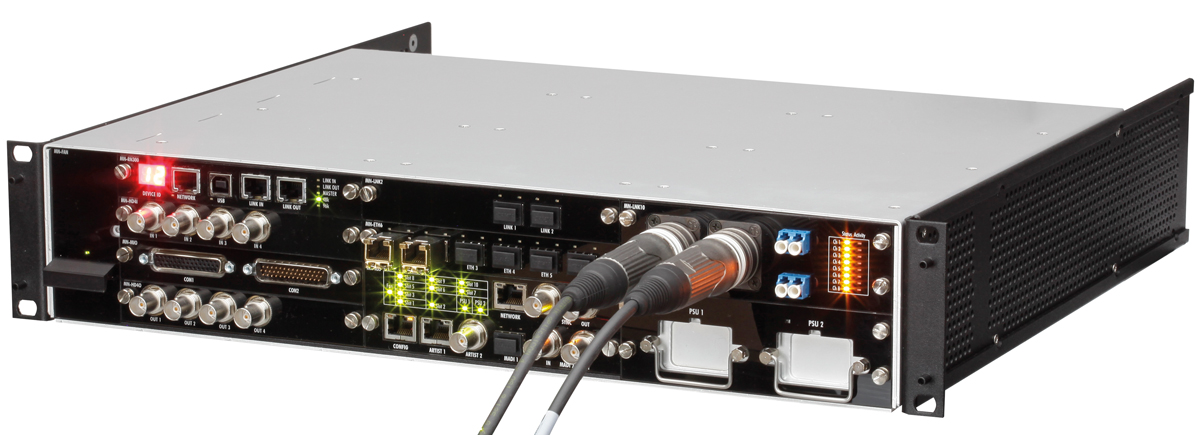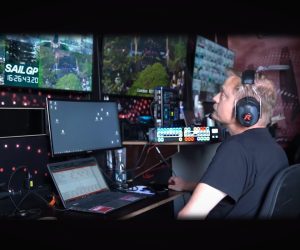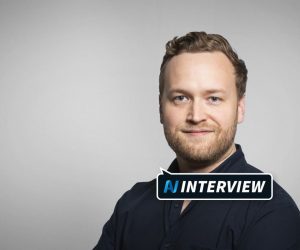
Riedel MediorNet Compact
Video, audio, data and comms distribution over fibre
Text:/ Ian Anderson
Not enough time to make events as grand as you imagined? You’ve got multiple departments all running cables to and from the same locations? Need a flexible system to distribute around a venue to lighting, audio, visuals, automation, outside broadcast and of course those other 631 people who think they need a monitor, audio feed and access to the internet? Riedel may have a product that is flexible enough to solve all of these problems for you.
‘Real Time Media Network’ and ‘21st Century Stagebox’ are two terms used by Riedel to describe its MediorNet Compact range of devices. The systems provide a fibre-based distribution network designed to combine all types of signals down a common pipe. This Compact range is part of a broader MediorNet family which includes a completely modular system designed for large-scale rental and broadcast environments where quick turnarounds and large numbers of mission-critical feeds are required. Showing its interest in all areas of production, Riedel has included a host of signal types from a contact closure to multiplexing other external fibre ports onto the one system.
The Compact range brings all of the functionality of the proven modular systems into three models: a Compact BASIC, Compact PLUS and Compact PRO. As with any range of products they gather more functionality as they go along. For this review I had a BASIC and a PRO set up on my kitchen table connected by 4m lengths of fibre. All units are 3RU and look like they are meant to be in any rack. Connections are well laid out with plenty of lights to tell you what’s going on and the front panels are full with industry-standard connectors for all the different signal types.
Once you see the units in place you realise the infrastructure and time saving you will gain from this type of integrated system. For example, if you consider the cabling that is run typically into a venue from a OB truck to a FOH location where lighting, audio, production callers, screen control and autocue operators are all located. All these departments require different levels of interconnection to and from the broadcaster as shown in the example below.
To Lighting:
Program Vision, Router Vision,
Router control, Timecode,
From Lighting:
GPI triggers, Wide shot vision
to router
To Audio:
High level VTR replays, sub mixes or
individual mic channels, timecode
From Audio:
High level CD/computer replay,
sub mixes
To Callers:
Program Vision, Camera
Multiview output
From Callers:
GPI triggers, Timecode,
rehearsal microphone
To Screen Control:
Camera feeds, VTR feeds,
Sync, Timecode
From Screen Control:
Computer outputs, Audio replay
To Autocue:
Program Vision and Audio
From Autocue:
Cue vision
The count of individual cables is well over 15 even including multicores. Not to mention heavy copper cabling. All of these signals can be transported over fibre already but usually with several systems all operating individually and incompatibly. The beauty of the MediorNet is that it gathers all of these different signals and combines them in a single integrated network.
The network bandwidth is up to 50Gb/s. This in real terms is up to 12 HD-SDI video signals, dozens of MADI streams or GBit-Ethernet signals and hundreds of channels of audio or intercom ports. One of the stand out features of this fibre system is it doesn’t just send signals from one input to a set output at the other end. It is able to route any signal to any other like connector on the system. This all happens in real time.
The operating software stays loaded onto the frames so all you need to do is hop on the network and type in the IP address of the frame you are connected to in your browser, and it’s show time. You will be asked to download from the frame the Mediorworks program for your Mac or PC and from then you can begin to configure the individual frames for use, or make adjustments to a currently functioning network.
As with other Riedel products you can set up your network topography visually in a window, see all I/O in its simplest form or create groups and custom layouts for more complicated routing or network monitoring. Custom labelling is easy, however the default names for the frames and all the I/O in the network is pretty self-explanatory and will get you going quickly.
As with any other routing type of product, sources and destinations are shown in the software. Different formats and types of signals are all well visualised with colour and their labels in the system. A simple drag and drop is all that is required to make a connection. The computer will say “no” if you are trying to send a HD signal down a contact closure. It will also let you know if you have reached any system limitations such as network bandwidth.
For more complex routing scenarios groups of the same formats can be configured in a typical matrix view. Here you can lock or unlock connections and easily see if inputs are going to multiple destinations, and so on. Video outputs can have on screen displays showing the configuration and in addition all of the embedded audio can be re-routed as required.
The system shows how the fibre up- and down-links are loaded with the bandwidth and power levels required for the current configuration and a comprehensive error/activity log is available.
The fibre network can be set up in a typical star configuration, redundant loop or point to point. Depending on the number and types of fibre connections you make between frames, MediorNet can prioritise how all of the signals deal with loss of network bandwidth. The fibre connection trend here in Australia tends to be the WDM OpticalCON QUAD module. This will allow six high-speed MediorNet links in the one connector. Plenty of other fibre options are supported and available to suit current infrastructure, including the 4.25G opticalCON DUO and standard LC or ST connectors.
The video signal paths can be either 3GB, HD-SDI, or SDI. The BASIC comes with two In and two Out, the PRO with four In and four Out as standard, but adding one of the three video option boards allows an additional four In/four Out or eight In or eight Out. Two display ports are also available for routing signals. Each unit has a sync input and at least one sync output, the PRO has three sync outputs. This allows the user to sync any free-running signals to the same reference (blackburst or TriLevel) completely within the network or sync external devices to the network. A nice feature is the test pattern generator. This is available on all inputs and outputs to the system (video and audio).
Audio I/O is taken care of from analogue with two In/two Out on the BASIC and four In/four Out on the PRO to the same number of AES/EBU connections. MADI (optical) has one on the BASIC and two on the PRO. There is a built-in 16-channel embedder/de embeder that can move any AES/EBU signal around as required.
Other media signals include 10 configurable GPIO, Ethernet and serial (RS422, RS232, RS485). Each unit has two auto-sensing power inputs as well as a 12VDC input.
Riedel’s Rocknet system is also supported in the PLUS and the PRO. This is another clever system that allows low-latency audio distribution via I/O that simply connects via its own network. Some audio consoles are also being integrated with various slot-in cards. The complete system looks and feels like a standard analogue split system and is built to be on the road.
Third-party interfaces are always in development, but currently the system will talk to the standard ProBel broadcast router protocol and also to TSL screen systems. This makes the system a perfect companion to broadcast facilities that require lots of external locations like commentary boxes, sidelines and hosting positions.
There are a few fancy things the system will do. All of the BNC connectors are internally lit and depending on signal availability or test patterns that may be assigned they will change colour. The other signal types also have indicators showing signal presence. The ability to flash all the lights on a unit to indicate which unit requires attention to a person in the field is a good idea, and looks great in the dark!
The MediorNet Compact range is one of those devices that keep events going. They are not designed to be on show to but be an integral part of connecting many disciplines in the performance and broadcast worlds. The hardest part of using any system like this is getting everyone talking the same language and willing to combine resources to make big tasks that much easier. Here’s to working together.
Reidel: www.riedel.net
RRP
MediorNet Compact BASIC $14,36.20 (inc GST)
MediorNet Compact PLUS $15,842.20 (inc GST)
MediorNet Compact PRO $22,574.20 (inc GST)
















RESPONSES